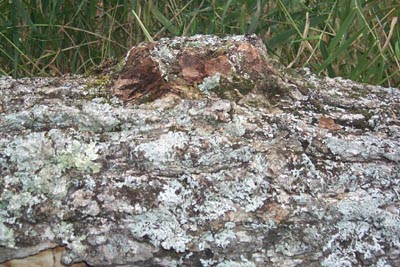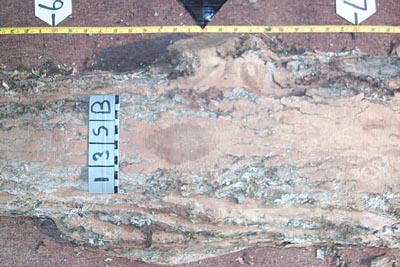
| Home |
| Tutorial |
| Photo Gallery |
| List of Defects |
| Links |
Significance: A knot on the surface of the log or a branch on a tree always represents a knot in the underlying wood.
In veneer logs, knots are admitted if they are no more than 10 inches (25.4 cm) from either or both ends or if they occupy no more than 1 foot (30.5 cm) of log length. However, all knots must be contained within one-quarter of all the circumference for logs with a 12 to 15 inch (30.5 to 38.1 cm) scaling diameter. They can be in different quarters for logs with a larger scaling diameter. 
In factory logs, the degrading effect of knots is determined by the distribution rather than by size, character, or condition of the individual knots. Obviously, large knots limit cuttings more than small knots. But a knot in lumber, no matter how small, limits a cutting under standard hardwood lumber grades. Thus, any knot is a degrader in factory logs. Knots from epicormic or sprout limbs must be considered under special instructions for factory logs. Although a particular knot of this origin may taper out at a shallow depth, it generally indicates successive layers of lumber knots for an indefinite depth into the wood.
In construction logs, the degrading effect of a knot depends on an entirely different set of conditions. An underlying lumber knot that it larger than one-fourth of the face of the largest included timber (measured on the small end of the log), or that is rotten is a defect because it will affect the strength of the piece.
With respect to size, unsound knots are judged by the same rules as sound ones, but the rot cannot extend more than 3 inches (7.6 cm) into the included timber. In practice, this means that an unsound knot of acceptable size is a degrader if the rot extends into the log for a distance exceeding one-fifth of the log diameter.
In standing trees, knots are by far the defect most often encountered in appraising hardwood timber. Often, limbs break off in the lower and middle crown. The stub dies and, if fungi gain entry, the stub will become a rotten knot and may even channel rot into the heartwood of the tree. If the branch stub is not infected by fungi, the dead knot becomes very hard because of drying, but may become infected by staincausing bacteria and cause stain zones to develop within the tree stem rather than rot columns. Many dead knots in the hard hardwood species react this way.
| Bark Distortion |
| Bird Peck |
| Bumps |
| Burls |
| Butt Scars |
| Butt Swells |
| Cankers |
| Conks |
| Epicormic Branches |
| Flanges |
| Flutes |
| Forks |
| Galls |
| Holes |
| Knots |
| Lesions |
| Limbs |
| Ring Shake |
| Rot |
| Seams |
| Soak |
| Splits |
| Wounds |

